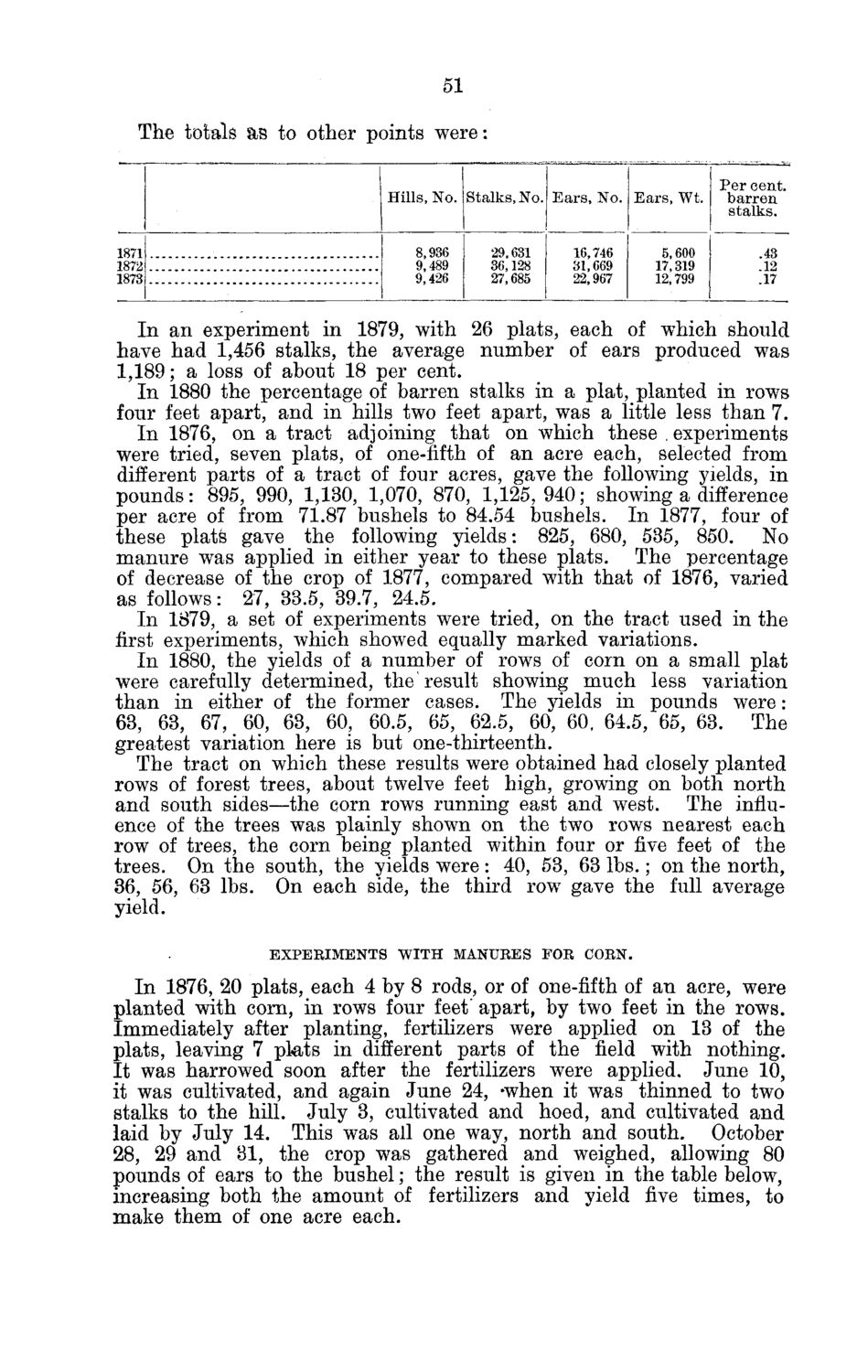| |
| |
Caption: Board of Trustees Minutes - 1880
This is a reduced-resolution page image for fast online browsing.

EXTRACTED TEXT FROM PAGE:
51 The totals as to other points were: Hills, No. Stalks, No. E a r s , No. E a r s , Wt. P e r cent, barren stalks. .43 .12 .17 1871 187'4 1873 8,936 9,489 9,426 29,631 36,128 27,685 16,746 31,669 22,967 5,600 17,319 12,799 In an experiment in 1879, with 26 plats, each of which should have had 1,456 stalks, the average number of ears produced was 1,189; a loss of about 18 per cent. In 1880 the percentage of barren stalks in a plat, planted in rows four feet apart, and in hills two feet apart, was a little less than 7. In 1876, on a tract adjoining that on which these . experiments were tried, seven plats, of one-fifth of an acre each, selected from different parts of a tract of four acres, gave the following yields, in pounds: 895, 990, 1,130, 1,070, 870, 1,125,940; showing a difference per acre of from 71.87 bushels to 84.54 bushels. In 1877, four of these platk gave the following yields: 825, 680, 535, 850. No manure was applied in either year to these plats. The percentage of decrease of the crop of 1877, compared with that of 1876, varied as follows: 27, 33.5, 39.7, 24.5. In 1879, a set of experiments were tried, on the tract used in the first experiments, which showed equally marked variations. In 1880, the yields of a number of rows of corn on a small plat were carefully determined, the result showing much less variation than in either of the former cases. The yields in pounds were: 63, 63, 67, 60, 63, 60, 60.5, 65, 62.5, 60, 60, 64.5, 65, 63. The greatest variation here is but one-thirteenth. The tract on which these results were obtained had closely planted rows of forest trees, about twelve feet high, growing on both north and south sides—the corn rows running east and west. The influence of the trees was plainly shown on the two rows nearest each row of trees, the corn being planted within four or five feet of the trees. On the south, the yields were : 40, 53, 63 lbs.; on the north, 36, 56, 63 lbs. On each side, the third row gave the full average yield. EXPERIMENTS WITH MANURES FOR CORN. In 1876, 20 plats, each 4 by 8 rods, or of one-fifth of an acre, were planted with corn, in rows four feet' apart, by two feet in the rows. Immediately after planting, fertilizers were applied on 13 of the plats, leaving 7 plats in different parts of the field with nothing. It was harrowed soon after the fertilizers were applied. June 10, it was cultivated, and again June 24, *when it was thinned to two stalks to the hill. July 3, cultivated and hoed, and cultivated and laid by July 14. This was all one way, north and south. October 28, 29 and 31, the crop was gathered and weighed, allowing 80 pounds of ears to the bushel; the result is given in the table below, increasing both the amount of fertilizers and yield five times, to make them of one acre each.
| |